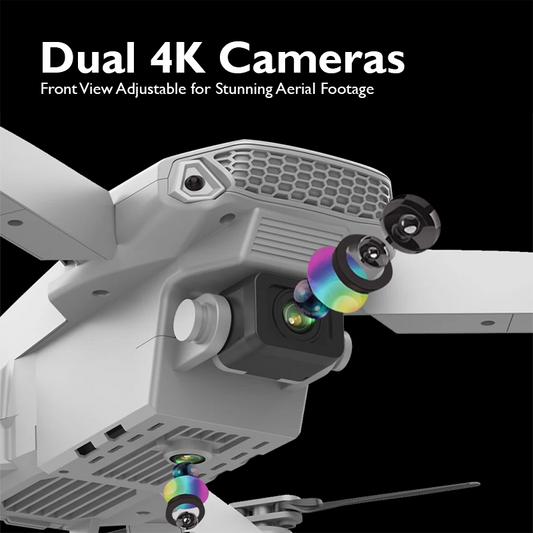The Role of Drones in Emergency Medicine

In the fast-evolving landscape of emergency medicine, technological advancements continue to reshape the way healthcare professionals respond to critical situations. Among these innovations, drones have emerged as a game-changer, offering unprecedented capabilities in delivering swift and efficient medical aid. This article explores the multifaceted role of drones in emergency medicine, shedding light on their potential to revolutionise crisis response and save lives.
Understanding the Landscape:

Emergency situations demand rapid and precise responses, often in challenging environments. Whether it's a natural disaster, a mass casualty incident, or a remote location with limited accessibility, the need for quick medical intervention is paramount. Drones, also known as Unmanned Aerial Vehicles (UAVs), have stepped into this arena, showcasing their ability to navigate difficult terrains and deliver medical supplies with unparalleled speed.
1.Rapid Response and Timely Intervention:

Drones excel in reaching inaccessible or hazardous locations swiftly. In emergency situations, every minute counts, and the speed of response can be a decisive factor in saving lives. Drones equipped with medical supplies can be dispatched rapidly to deliver critical aid such as medications, defibrillators, or even blood transfusion kits to remote or disaster-stricken areas, bridging the gap until traditional medical personnel can arrive.
2.Aerial Surveys for Effective Triage:
In mass casualty incidents, the ability to assess the situation and prioritise interventions is crucial. Drones equipped with high-resolution cameras and thermal imaging can provide real-time aerial surveys, allowing emergency responders to conduct efficient triage. This technology aids in identifying the severity of injuries, locating survivors, and optimising the allocation of medical resources.
Advanced Medical Payloads:
Drones in emergency medicine go beyond mere transportation; they serve as versatile platforms for carrying specialised medical payloads. These payloads are designed to address specific needs in crisis scenarios, enhancing the overall effectiveness of emergency response efforts.
1.Defibrillator Drones for Cardiac Emergencies:

In cases of cardiac arrest, time is of the essence. Defibrillator-equipped drones can significantly reduce the time it takes to deliver life-saving shocks to a patient. These drones are equipped with automated external defibrillators (AEDs) and can reach the site of an emergency faster than traditional ambulances, increasing the chances of survival for those experiencing cardiac events.
2.Blood and Medication Delivery:

Drones have the capacity to transport essential medical supplies, including blood products and medications, to remote or disaster-stricken areas. This is particularly crucial in situations where road access is limited or compromised. The ability to deliver blood transfusion kits or critical medications within the golden hour can be a decisive factor in saving lives.
Overcoming Challenges with Innovative Solutions:

While the integration of drones in emergency medicine brings about transformative benefits, it is not without its challenges. Addressing these challenges is crucial to unlocking the full potential of drone technology in crisis response.
1.Regulatory Compliance:
Navigating the regulatory landscape is a significant hurdle for the widespread adoption of medical drones. Regulations must evolve to accommodate the unique requirements and safety measures associated with deploying drones for emergency medical purposes. Collaborative efforts between regulatory bodies, healthcare institutions, and drone manufacturers are essential to streamline compliance and ensure the responsible use of this technology.
2.Interoperability and Communication:
Effective communication between drones and existing emergency response systems is vital for seamless integration. Ensuring that drones can relay real-time data to medical professionals on the ground facilitates informed decision-making and enhances overall coordination. Interoperability standards must be established to create a cohesive ecosystem where drones complement existing emergency medical services.
Real-world Impact of Drone Integration:
To emphasise the tangible benefits of drone integration in emergency medicine, let's examine a few real-world case studies that showcase the transformative impact of this technology.
1.Zipline's Medical Drone Delivery in Rwanda:

In Rwanda, Zipline, a drone delivery service, has revolutionised the delivery of medical supplies. Operating a fleet of autonomous drones, Zipline delivers blood, vaccines, and other essential medical products to remote health facilities. This initiative has significantly reduced the time it takes to transport critical supplies, especially in emergencies.
2.Drones for Cardiac Arrest Response in Sweden:

In Sweden, a pilot project explored the use of drones equipped with defibrillators to respond to cardiac arrests. The drones, developed by the Swedish Transportation Agency, demonstrated the potential to decrease response times and improve survival rates in cardiac emergencies. The success of this project underscores the practical application of drones in time-sensitive medical interventions.
Future Prospects of Drone Technology in Emergency Medicine:

As technology continues to advance, the future holds even greater possibilities for the integration of drones in emergency medicine. Here are some exciting prospects on the horizon:
1.Autonomous Aerial Ambulances:
Imagine a future where autonomous aerial ambulances equipped with advanced medical capabilities respond to emergencies without human piloting. This concept is gaining traction, with prototypes being developed to transport medical personnel and equipment rapidly to critical situations.
2.AI-Driven Decision Support:
Artificial Intelligence (AI) has the potential to play a pivotal role in enhancing the capabilities of medical drones. AI algorithms can analyse data from various sensors, interpret medical images, and provide real-time decision support to emergency responders. This integration of AI-driven insights can significantly improve the efficiency and effectiveness of medical interventions.
The role of drones in emergency medicine is rapidly evolving, and their impact on crisis response is undeniable. From delivering life-saving medical supplies to providing aerial surveys for efficient triage, drones have proven their effectiveness in diverse emergency scenarios. As we navigate the challenges of regulatory compliance and technological integration, the promise of a future where drones seamlessly complement traditional emergency medical services is within reach. The collaboration between healthcare institutions, regulatory bodies, and technology innovators will be instrumental in unlocking the full potential of drones and ushering in a new era of rapid and effective emergency medical interventions. In the quest to save lives, drones are soaring to new heights, reshaping the landscape of emergency medicine for the better.
Explore a variety of drones at our online drone store.
Happy Flying!











